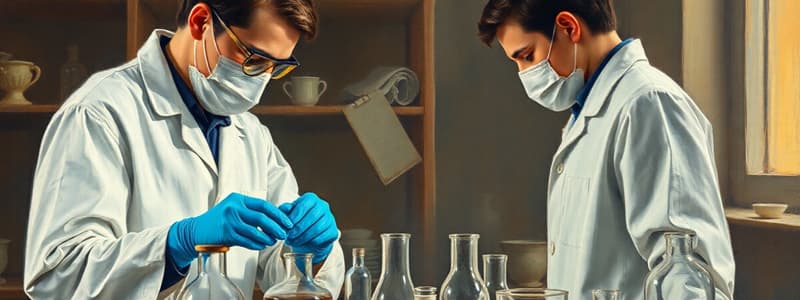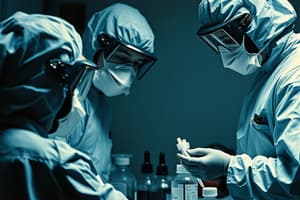Podcast
Questions and Answers
What should you never do with chemicals unless it is part of the experimental procedure?
What should you never do with chemicals unless it is part of the experimental procedure?
- Store them in unmarked containers
- Mix them with other substances
- Shake them vigorously
- Taste or intentionally sniff them (correct)
Which of the following items should not be applied in the laboratory or storage area?
Which of the following items should not be applied in the laboratory or storage area?
- Cosmetics (correct)
- Sunscreen
- Medicinal ointments
- Hand sanitizer
What is the correct method for disposing of broken glassware in the lab?
What is the correct method for disposing of broken glassware in the lab?
- Throw it in the regular trash
- Leave it for the instructor to handle
- Wrap it in paper and store it on the bench
- Dispose of it immediately in designated containers (correct)
Which emergency procedure requires knowing how to operate a fire extinguisher?
Which emergency procedure requires knowing how to operate a fire extinguisher?
What is the main difference between mass and weight?
What is the main difference between mass and weight?
Which laboratory equipment is typically used for measuring specific volumes of liquids?
Which laboratory equipment is typically used for measuring specific volumes of liquids?
What must be done when leaving the laboratory after using chemicals?
What must be done when leaving the laboratory after using chemicals?
Which of the following techniques is NOT essential for reliable observations in the laboratory?
Which of the following techniques is NOT essential for reliable observations in the laboratory?
What should be worn in the laboratory to ensure personal safety?
What should be worn in the laboratory to ensure personal safety?
What is the proper way to mix solutions in a test tube?
What is the proper way to mix solutions in a test tube?
Which of the following actions is prohibited inside the laboratory?
Which of the following actions is prohibited inside the laboratory?
When should you report spills or accidents in the laboratory?
When should you report spills or accidents in the laboratory?
What should you do if you need to handle hazardous chemicals?
What should you do if you need to handle hazardous chemicals?
Which footwear is appropriate for the laboratory environment?
Which footwear is appropriate for the laboratory environment?
What must be done with unlabeled chemicals?
What must be done with unlabeled chemicals?
What is the correct response when using a pipette?
What is the correct response when using a pipette?
Flashcards are hidden until you start studying
Study Notes
Laboratory Safety
- Unauthorized Experiments: Never conduct experiments without instructor supervision.
- Prohibited Activities: No smoking, practical jokes, or eating in the lab.
- Jewelry: Avoid wearing jewelry due to safety hazards.
- Hair: Tie back long hair.
- Personal Protective Equipment (PPE): Wear safety goggles and lab coats.
- Footwear: Wear closed-toe, low-heeled shoes with non-slip soles. Avoid sandals, open-toed, open-backed, or high-heeled shoes.
- Laboratory Tables: Do not sit on lab tables.
- Distractions: Avoid distracting or startling others.
- Electronics: No cell phone or earphone usage during lab work.
- Emergency Equipment: Know the locations of safety showers, eyewash stations, and fire extinguishers.
- Chemical Contact: Avoid skin and eye contact with chemicals.
- Hot Glassware: Handle hot glassware carefully.
- Spills and Accidents: Report any spills, injuries, or accidents to your instructor immediately.
- Leaving Experiments: Avoid leaving an experiment unattended while it is in progress.
- Equipment Use: Use equipment only for its intended purpose.
- Heating Apparatus: Turn off heating apparatus, gas valves, and water faucets when not in use.
- Test Tubes: Do not point the open end of a test tube at anyone while heating.
- Flammable Solvents: Ensure no flammable solvents are present when lighting a flame.
- Chemical Labels: All containers must have proper labels. Never use unlabeled chemicals.
- Fume Hoods: Work with hazardous chemicals in a properly functioning fume hood.
- Pipette Use: Use a pipetting device, never mouth suction, to fill pipettes.
- Solution Mixing: Do not use your thumb as a stopper. Swirl gently or use parafilm to mix solutions.
- Chemical Handling: Handle chemicals, reagents, and stains carefully. Follow all warnings on labels. Consult Material Safety Data Sheets (MSDS) for potentially hazardous chemicals.
- Tasting Chemicals: Do not taste or intentionally smell chemicals unless it is part of the experimental procedure.
- Laboratory Housekeeping: Keep your workspace clean and orderly.
- Hand Hygiene: Keep hands away from face, eyes, mouth, and body while using chemicals. Wash hands after removing gloves and before leaving the lab.
- Reagent Disposal: Do not pour reagents and chemicals down the sink. Dispose of them in designated containers.
- Sharp Objects Disposal: Dispose of broken glassware and sharp objects in designated containers.
- Workspace Cleaning: Thoroughly clean your workspace at the end of the lab session.
- Emergency Procedures: Know the location of all exits, emergency phones, and emergency numbers. Understand how to operate fire extinguishers, alarm systems, fire blankets, eye washes, first-aid kits, and safety showers. Follow the established emergency plan in case of an emergency or accident.
Laboratory Techniques
- Mass Measurement:
- Mass: The amount of material in a substance.
- Weight: Force due to gravity.
- Volume Determination:
- Graduated cylinders, pipettes, burettes, and volumetric flasks measure liquid volumes.
- Volumetric flasks and graduated cylinders measure the volume of liquids.
- Pipettes and burettes deliver specific volumes.
Studying That Suits You
Use AI to generate personalized quizzes and flashcards to suit your learning preferences.




